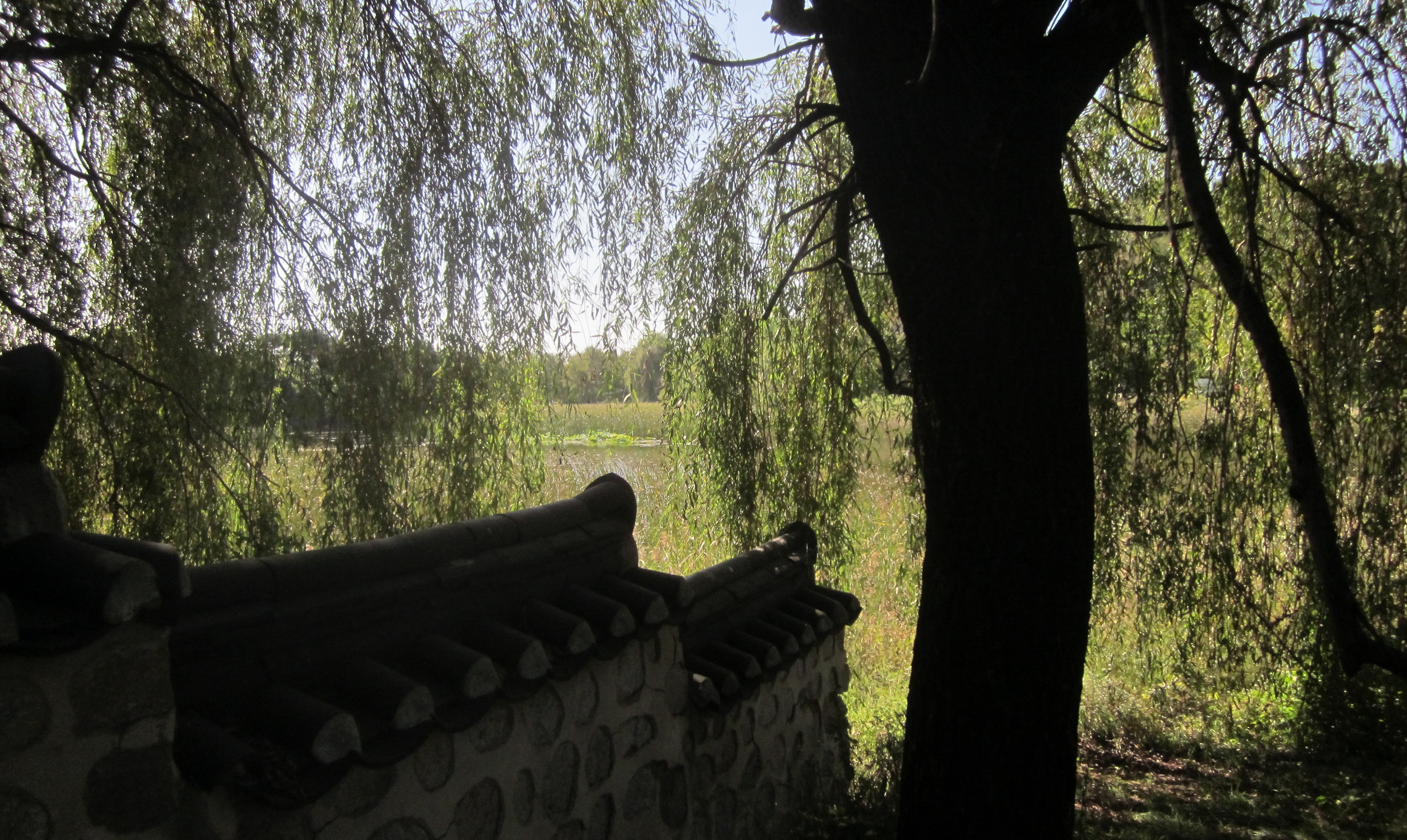This tree is a guest tree from my past. I took this picture while walking to work in April, 2017. I thought the ball looked forlorn and sad, so I took a picture – but the trees are interesting, too. I remember the exact spot where this ball was, along Juyeop plaza about half a block south of work.
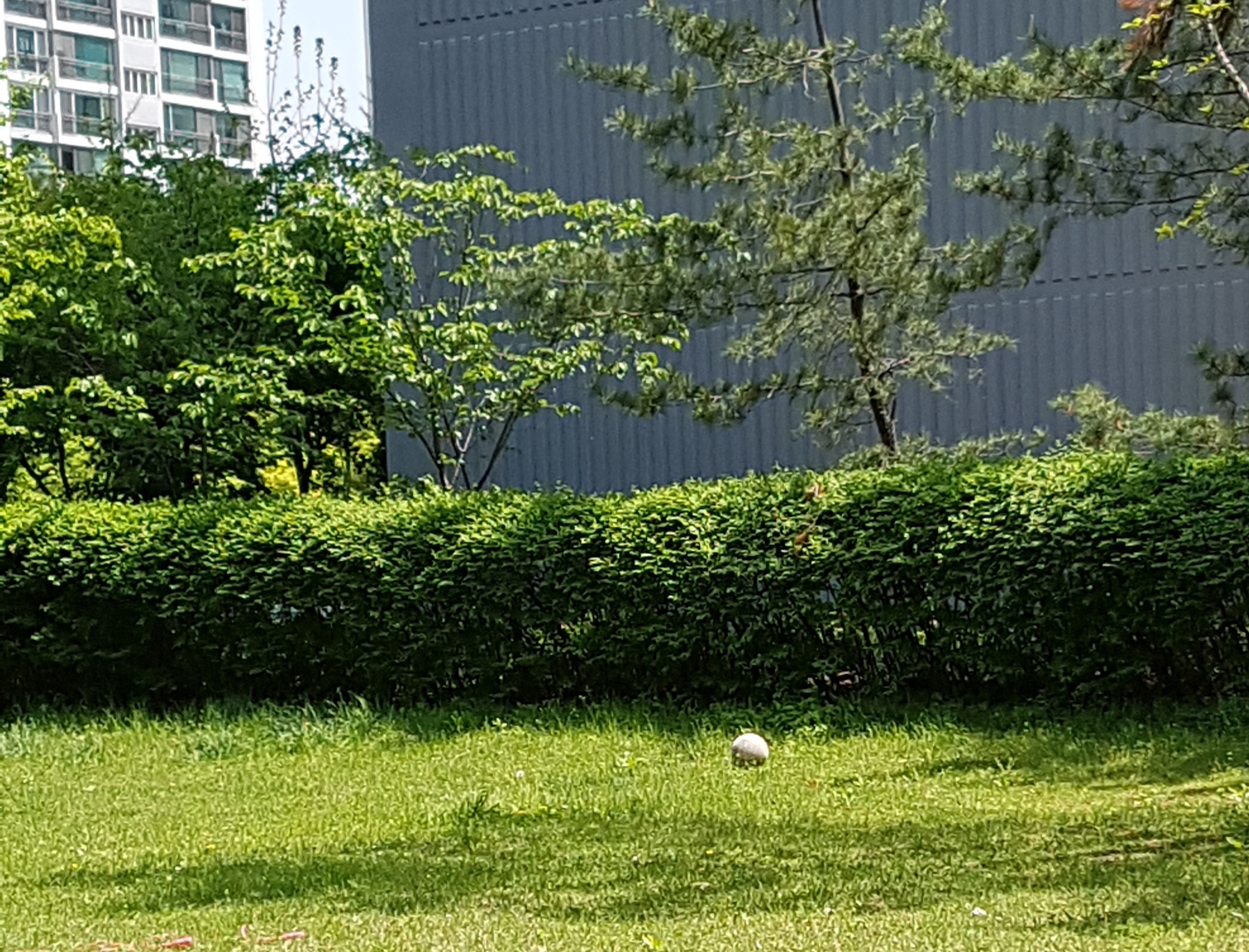
Category: Life in Korea
Caveat: Tree #1225
This tree is a guest tree from my past. I took this picture in early June, 2015, standing in front of my place of work. I was noting the “gentrification” of my neighborhood in Ilsan, Korea, via the opening of a new Starbucks location.

![]() [daily log: walking, 3.5km; dogwalking, 3km; c100066057084s]
[daily log: walking, 3.5km; dogwalking, 3km; c100066057084s]
Caveat: Tree #1207
This tree is a guest tree from my past. The tree is guarding an entrance to the Samgakji subway station in central Seoul – just southwest of the former Yongsan US military base. The base is “former”, now, but when I took this picture in April, 2008, it was still active. In the haze in the upper background you can see the Namsan Tower.
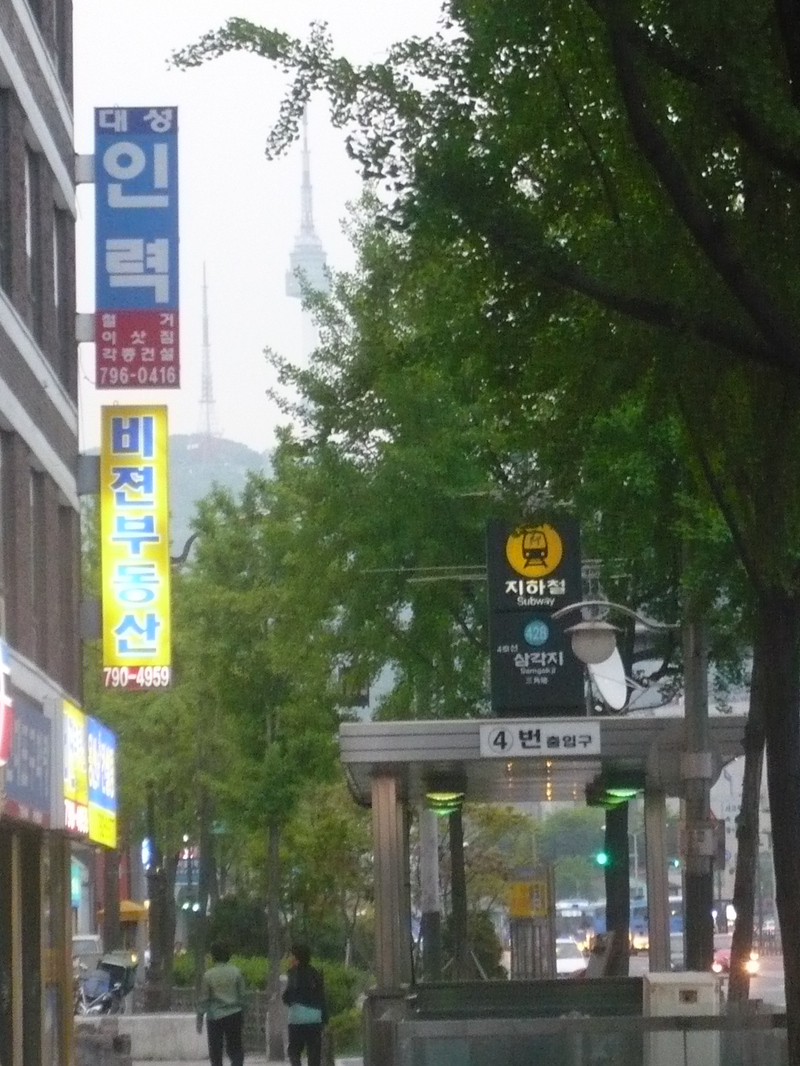
I went to work today – not a normal thing for a Monday, but I have a somewhat rearranged schedule this week.
Caveat: Tree #1196
This tree is a guest tree from my past. I don’t even know what year I took it – maybe 2012. But clearly it’s from the time around Buddha’s birthday holiday: the lanterns and temporary statuary in the river (which is the small book that bisects downtown Seoul, 청계천 [cheong-gye-cheon]) give it away.
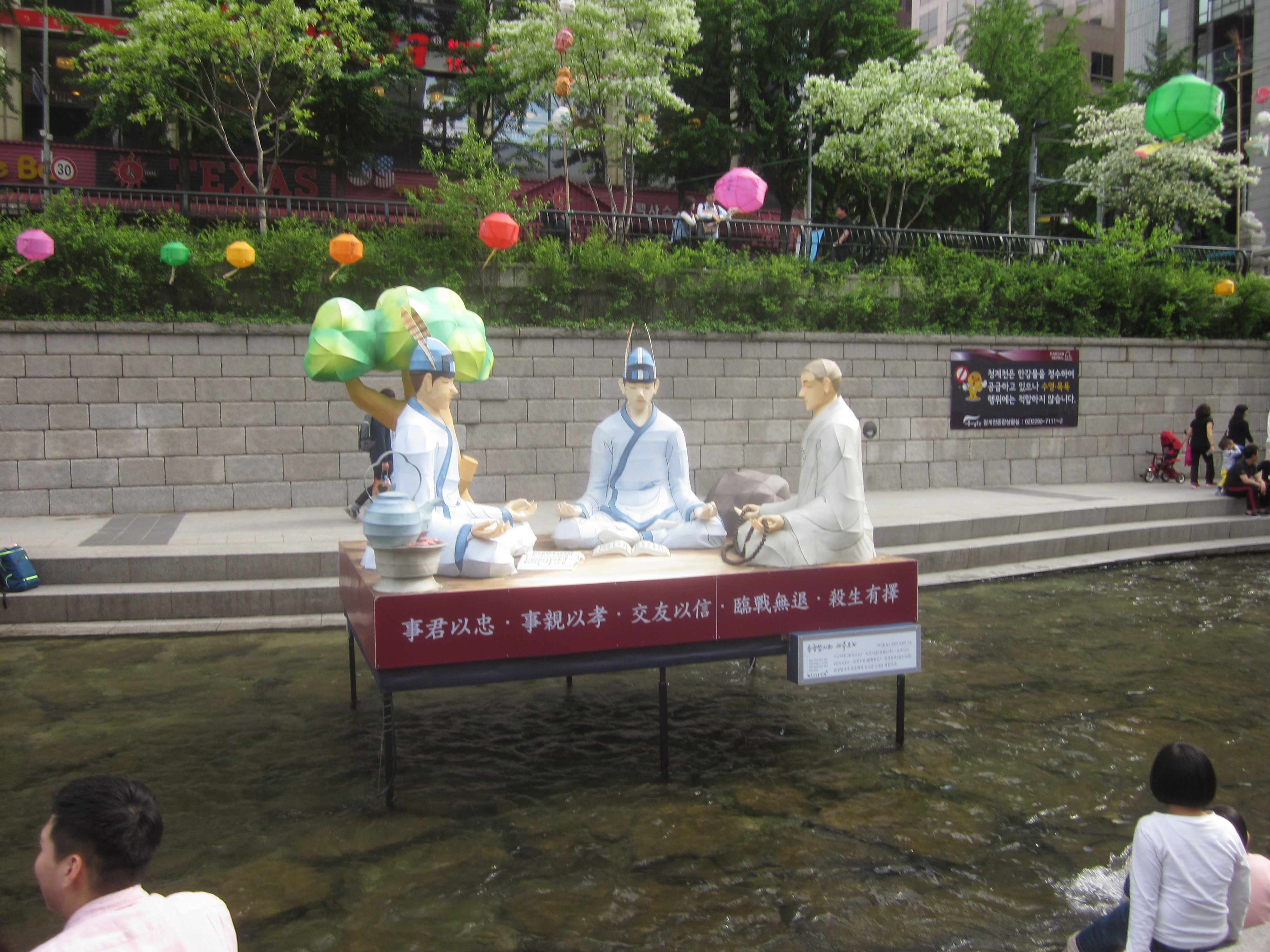
This year, Buddha’s birthday will be celebrated this coming Sunday, May 8th. It moves around (like Easter), due to the Korean lunar calendar. It used to be annoying when Buddhamas fell on a Sunday, because it would mean no extra day off from work.
Caveat: I will pray for your lucky
My coworker Jan, at the gift shop, likes to order various exotic herbal medicines and supplements, often from Asia. She ordered something from Korea not that long ago – I don’t know what it was (some kind of mushroom extract?). But when she got her product delivered, it included this note from the vendor.
To Buyer, Thank you so much for your purchase!!!!! I hope you had a pleasant transaction as much as I enjoyed:-) You are such a beautiful, gorgeous, perfect, incredible, fabulous, fantastic, the one-of-a-kind, mind-boggling, and Excellent buyer!!! Even though we are oceans apart, I feel it's my honour to have a chance to get to know you through Amazon.com. That's why I love having transactions on Amazon.com I will try to meet your needs by providing better service and products. I will pray for your lucky,if you leave a good feedback on Amazon.com. I wish that you are in good health and fortune with your family. Hope to deal with you again. Thank you. Have a wonderful day!!! Have a great day!!!! Many thanks and Kind regards, Kevin Kim
This made me nostalgic for my Korean students’ inimitable English style. This could have been written by one of them, easily. So much hyperbole!!!! So many exclamation points!!!!!!!!!
Caveat: Tree #1007
Caveat: Tree #1000
This tree is from my past. I took this picture at Jeongbalsan Park near my apartment, walking home from the cancer center, in September 2013.

Caveat: Poem #1892 “Gangnam style”
ㅁ I took the subway into Gangnam's heart and walked up Teheranno, through the crowd, immersed in human restlessness, alone - until the dream unmade itself at dawn.
– a quatrain in blank verse (iambic pentameter).
Here is a picture of the familiar streetscape in Gangnam, Seoul, a few blocks north of the main subway station. I was here every day for a few months in 2010, when I was studying Korean language full-time. So it sometimes appears in dreams.
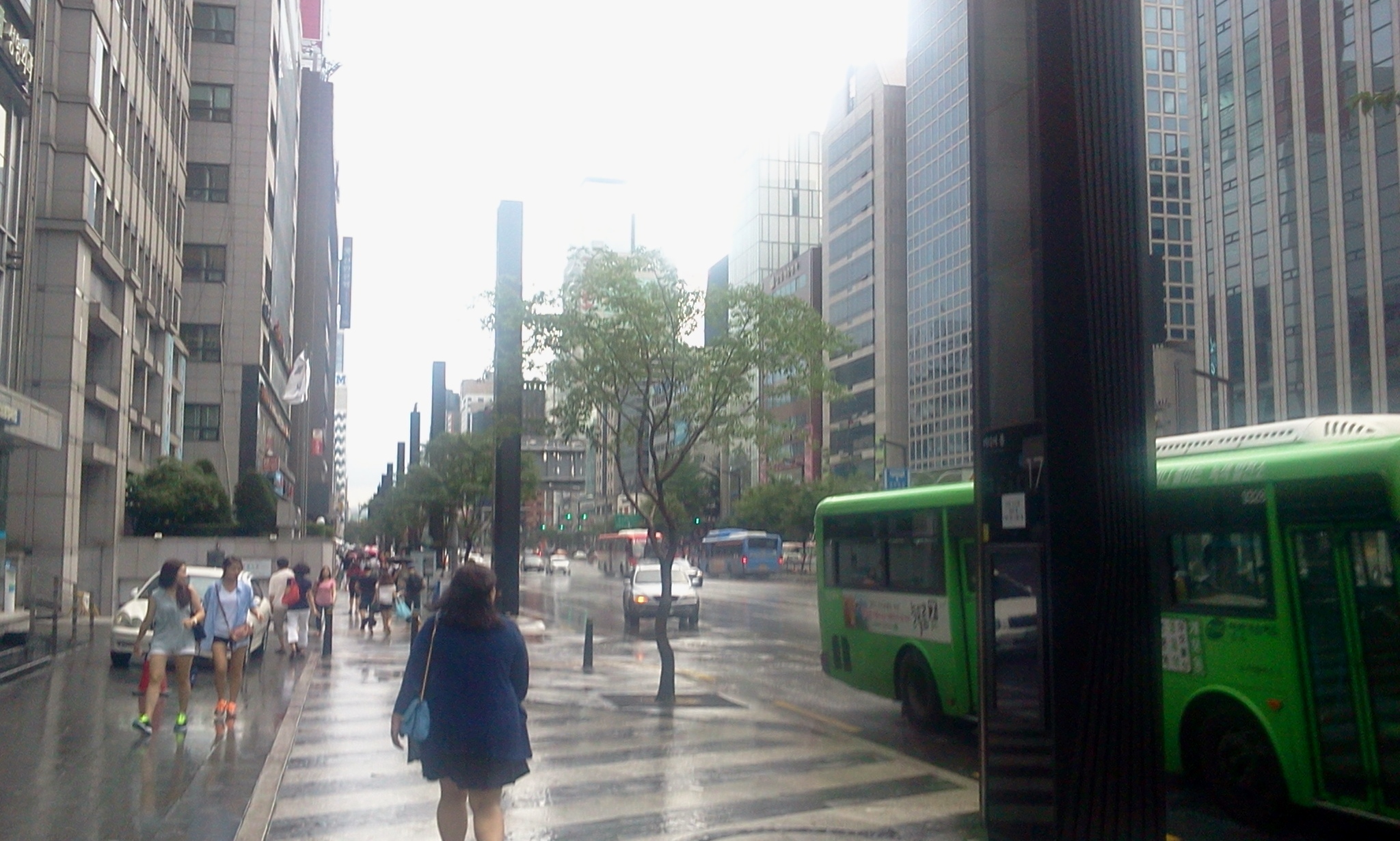
![]()
Caveat: Tree #952
This tree is under an elevated metro station from my past. Ten years ago this month I visited the Oksu station in Seoul, and took this picture. I don’t think the tree was the focus or subject of the picture, but nevertheless, there is a tree down there.
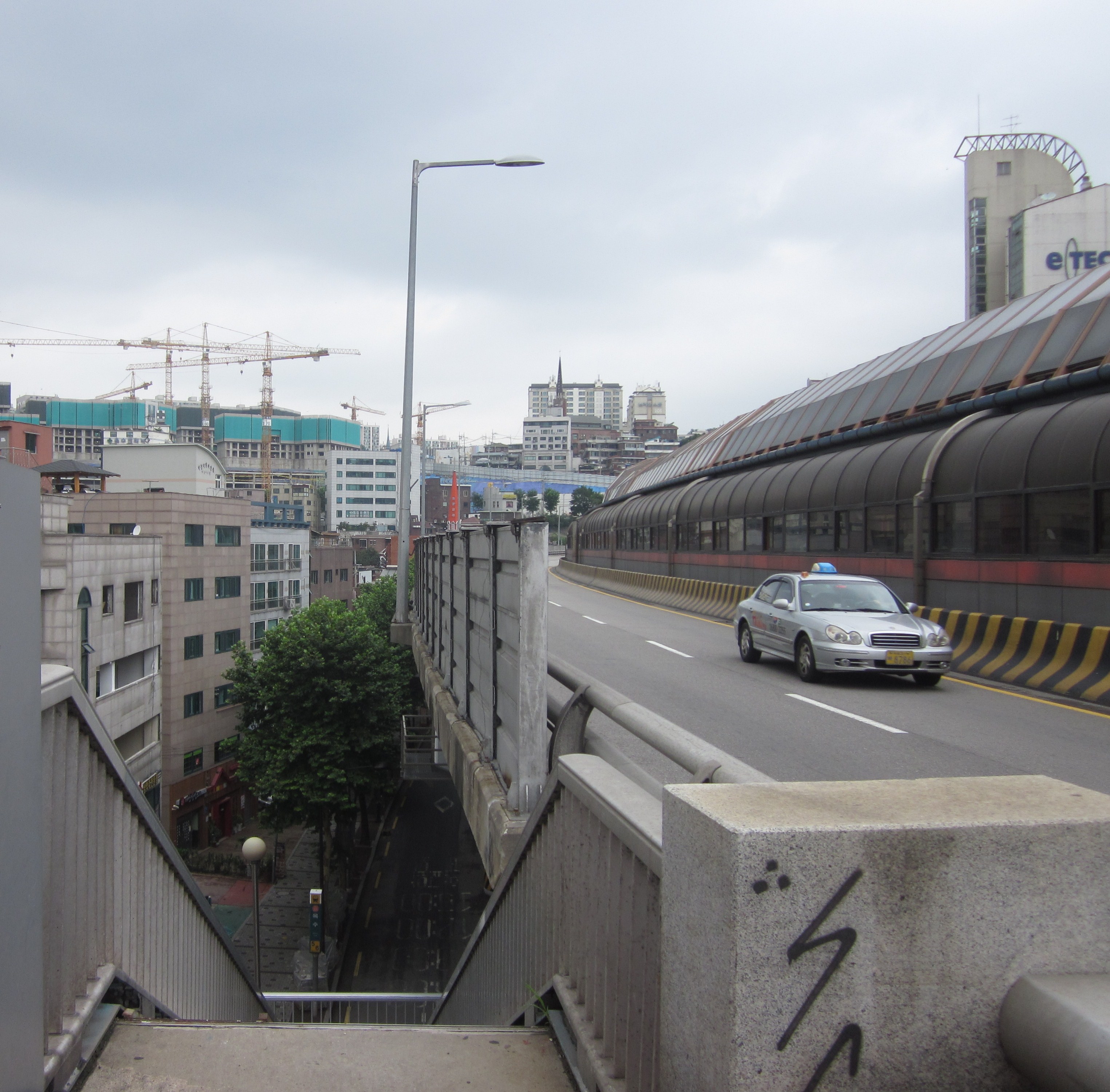
Caveat: Tree #923
This tree is from my past. It was witness to a rather ambitious hiking excursion I took with my brother in September, 2013, in southwestern South Korea – right during the time I was undergoing my 3-times-a-week radiation therapy for my cancer. This is on the mountain just west of Hongnong, between the town and the nuclear power plant on the coast. Hongnong is where I lived in 2010-2011. I remember being utterly exhausted from this trip.
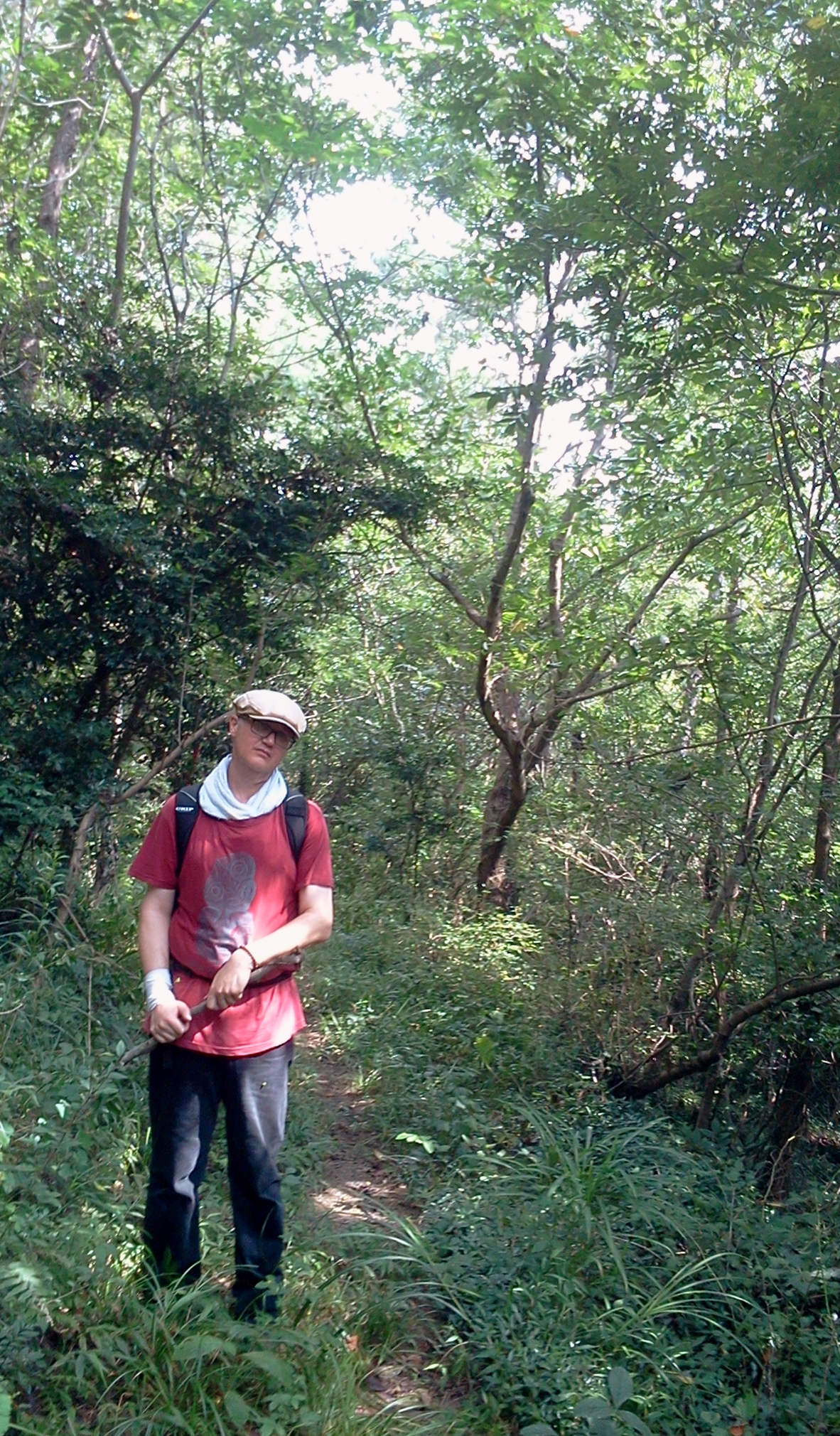
Caveat: Tree #911
This tree (from my past) is watching hot peppers dry in September, 2009. I saw it on the island named Ulleungdo off the east coast of South Korea.
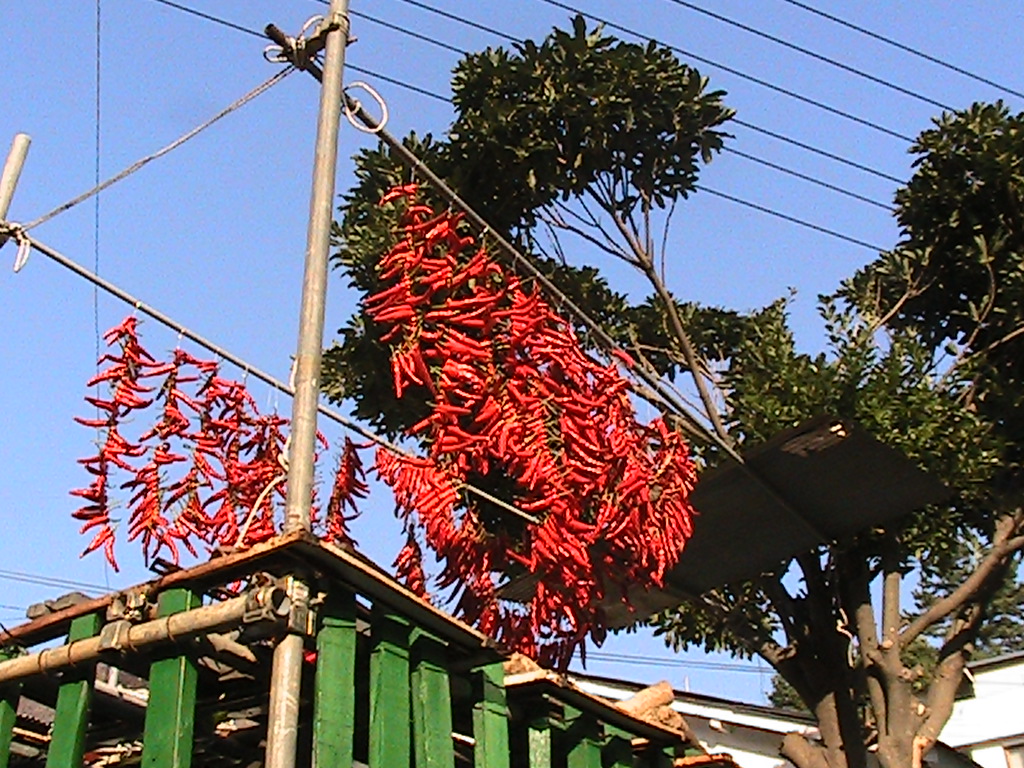
Caveat: Merry Seollal
In Korea, “Chinese New Year” is not, in fact, Chinese. It’s called 설날 (Seollal), i.e. Lunar New Year. I would prefer if that’s what it were called in English – “Chinese” feels culturally narrow if not incorrect.
새해 복 많이 받으세요.
![]()
Caveat: Tree #702
This tree was outside my classroom window almost exactly 10 years ago, in December, 2010, in Hongnong Village, Yeonggwang County, Jeollanam Province, South Korea.

I made a chocolate cake, to celebrate the impending winter solstice.
![]() [daily log: walking, 1km]
[daily log: walking, 1km]
Caveat: Tree #564
This tree is a guest tree from the past. It’s a Dawn Redwood (metasequoia), along my walk-to-work route in Ilsan, Korea, taken in November, 2017. The trees look and feel like the redwoods I grew up with in far northern California (sequoia sempervirens), but unlike those, these Asian redwoods turn color and lose their leaves (needles) in the Fall. Also, they don’t grow quite so tall. I’ve been “homesick” for Korea a lot, lately.
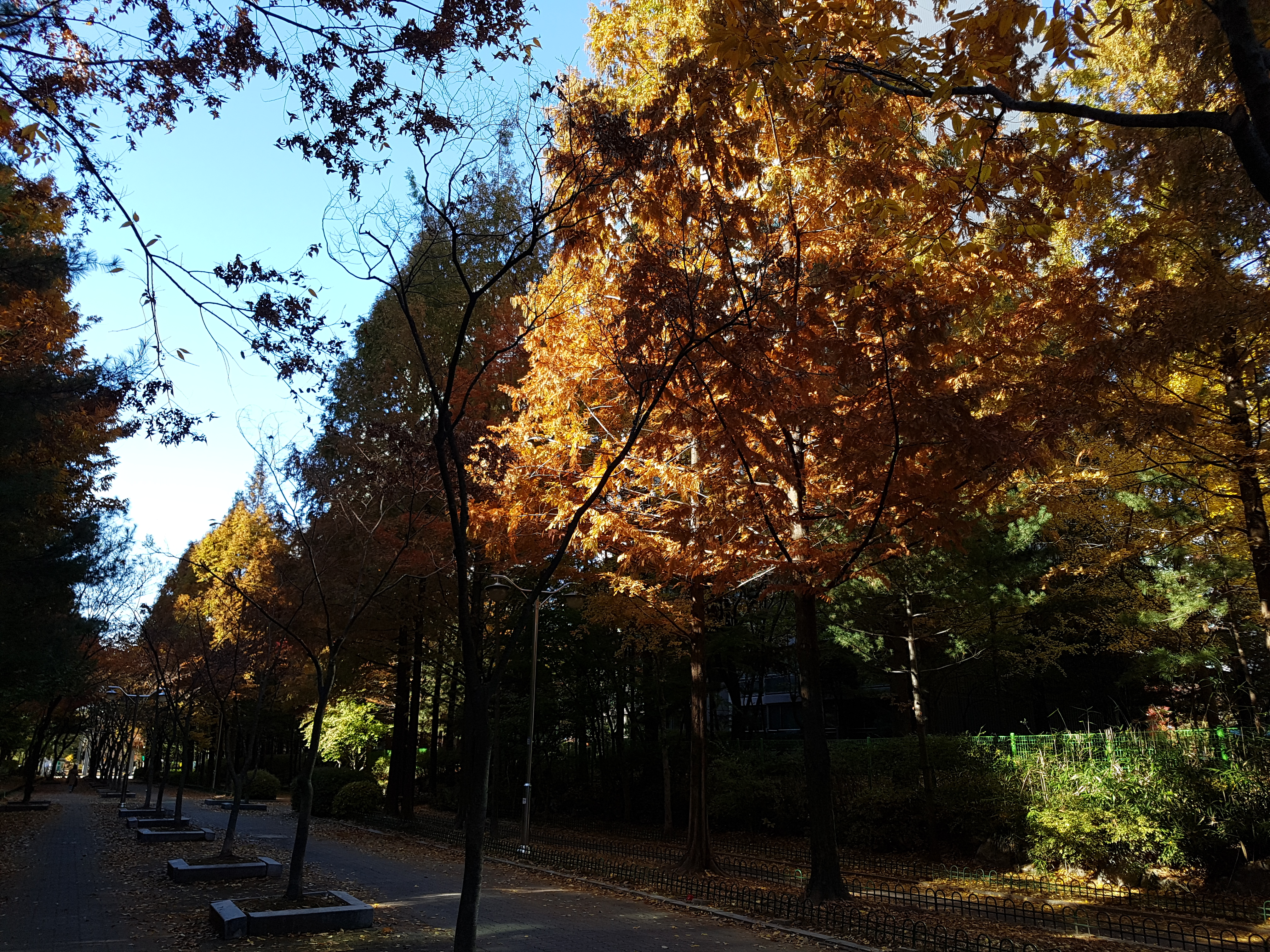
![]() [daily log: walking, 2km]
[daily log: walking, 2km]
Caveat: Tree #505
This tree was along my walking commute to work in Ilsan, Korea. I took this picture in November, 2015.

![]() [daily log: walking, 2km]
[daily log: walking, 2km]
Caveat: Tree #490
This tree is from my past. It was at a little historical park on the northern tip of Ganghwa Island, about 30 km northwest from my home in Ilsan, South Korea. I’d gone there when my mother was visiting me in Korea. I took the picture in October, 2013.
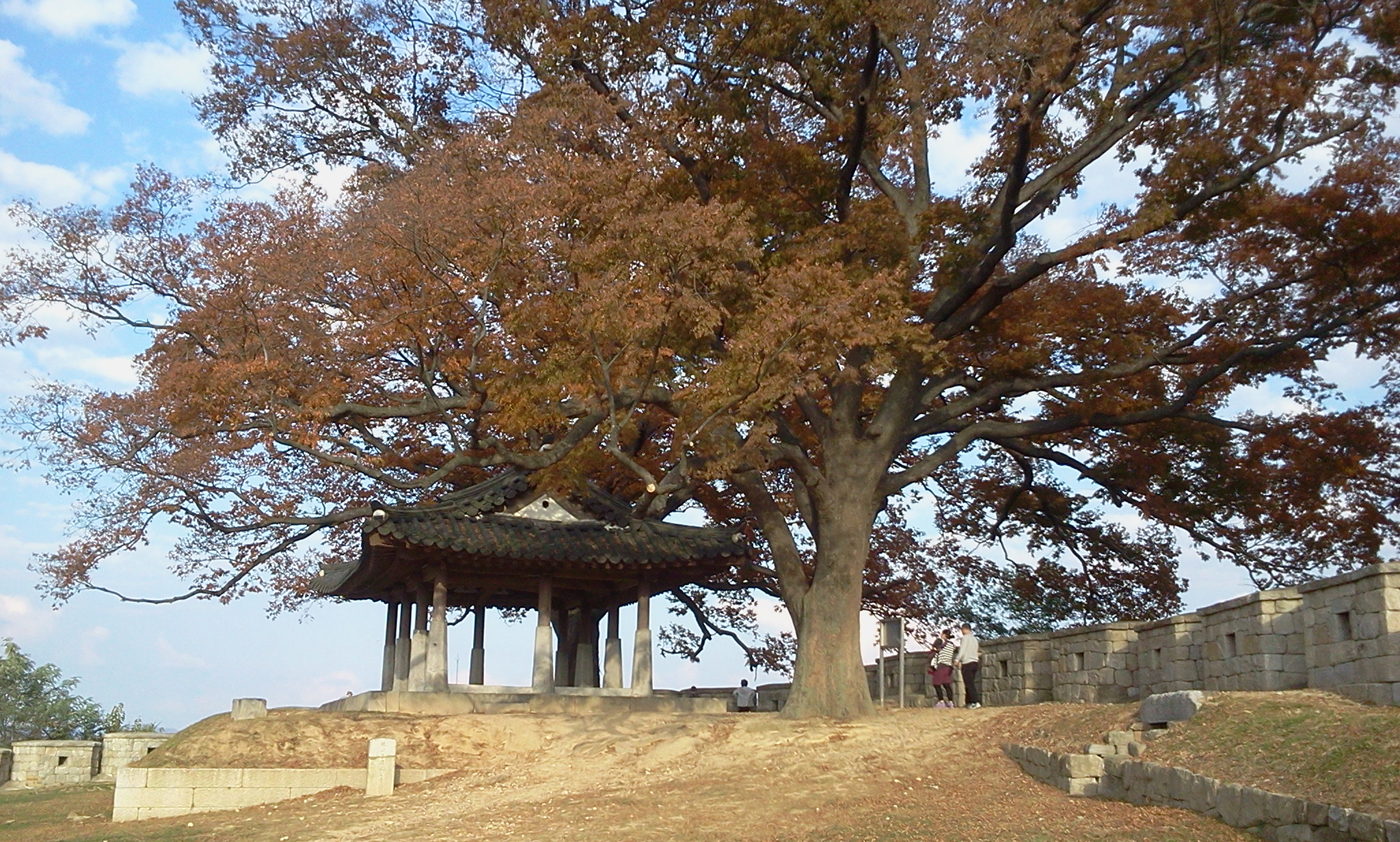
From the promontory at the little fortress there, you can see directly into North Korea, across the river – this is the part of the DMZ where the border runs in the river. A few hundred meters away from that tree, this is a view across the river. Those mountains in the distance are in North Korea. There are little coin-operated binoculars and you can look into the North Korean town over there.
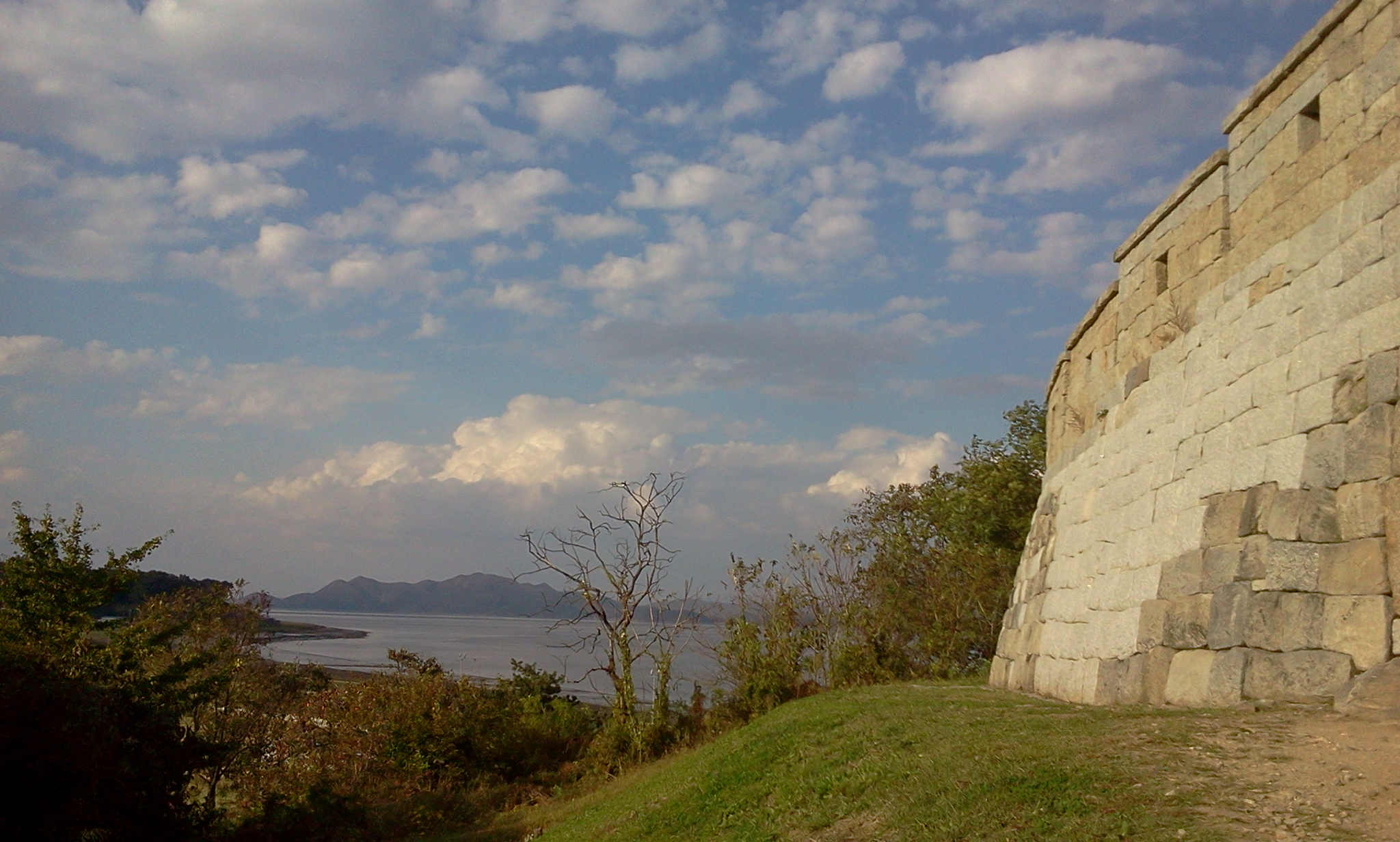
![]()
Caveat: Tree #484
This tree on the left foregrounds a view of Gobong, a prominent hill in Ilsan, my former Korean home. You can see the distinctive radio tower on the mountain. Nestled at the foot of the radio tower is the Yeochan Temple, which I often visited. I took this picture in Jeongbalsan Park a few blocks from my apartment in October, 2015.
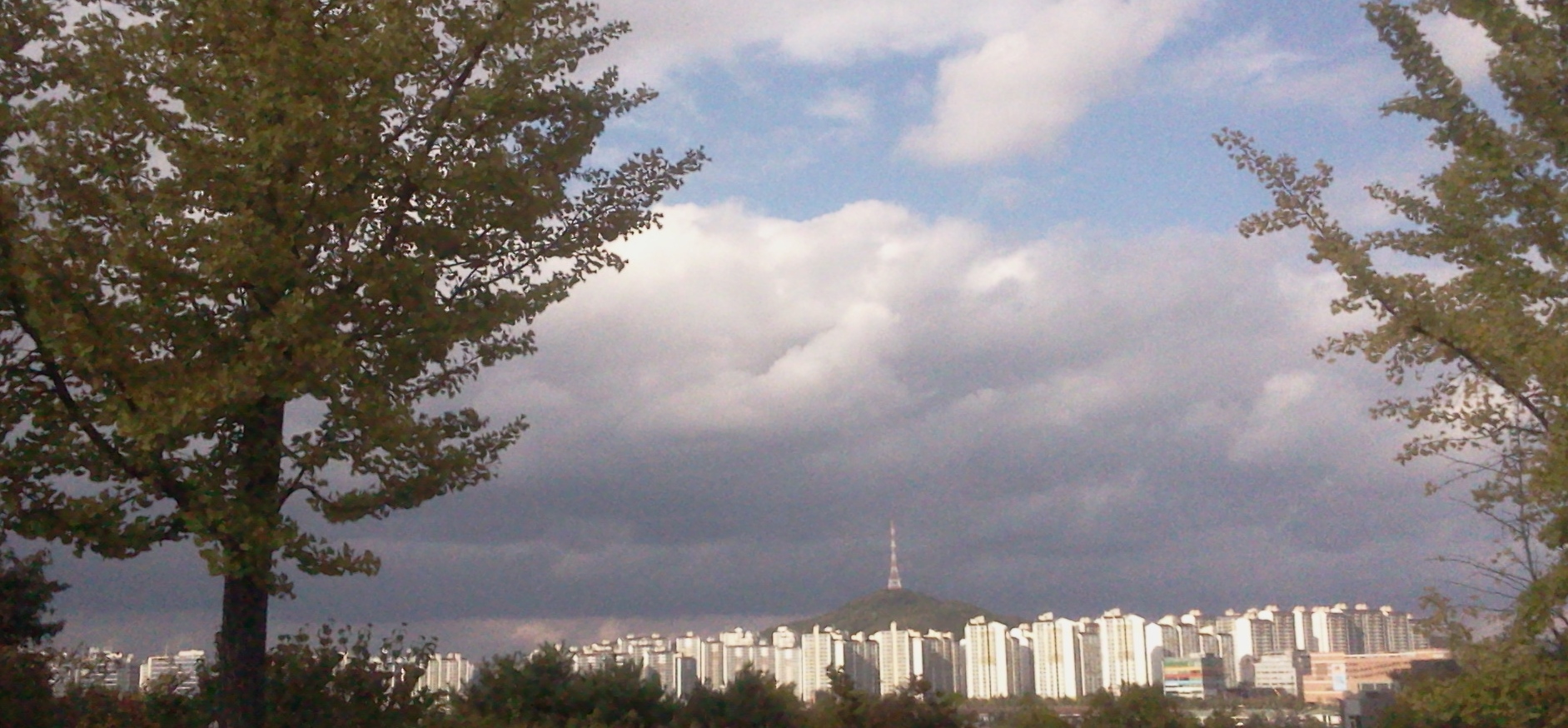
![]()
Caveat: Tree #480
This is a redwood tree. In fact, it is what is called metasequoia, or “dawn redwood,” a strange variety of redwood that loses its needles in winter. They are planted all over Seoul, though not native there.
I took this picture in January, 2009, in Goyang, Korea, a few blocks from my apartment.
![]() [daily log: walking, 1km]
[daily log: walking, 1km]
Caveat: Tree #471
This tree is from my past. I took this picture in April, 2015. I’m standing on the foot bridge that goes over Ilsan-no (Ilsan Road) in Ilsan, right in front of my place of employment, the Karma Language Academy (which is the orange and white sign on the building on the left). Spring in Korea was always kind of smoggy and horrible, but the blooming trees were sometimes beautiful.
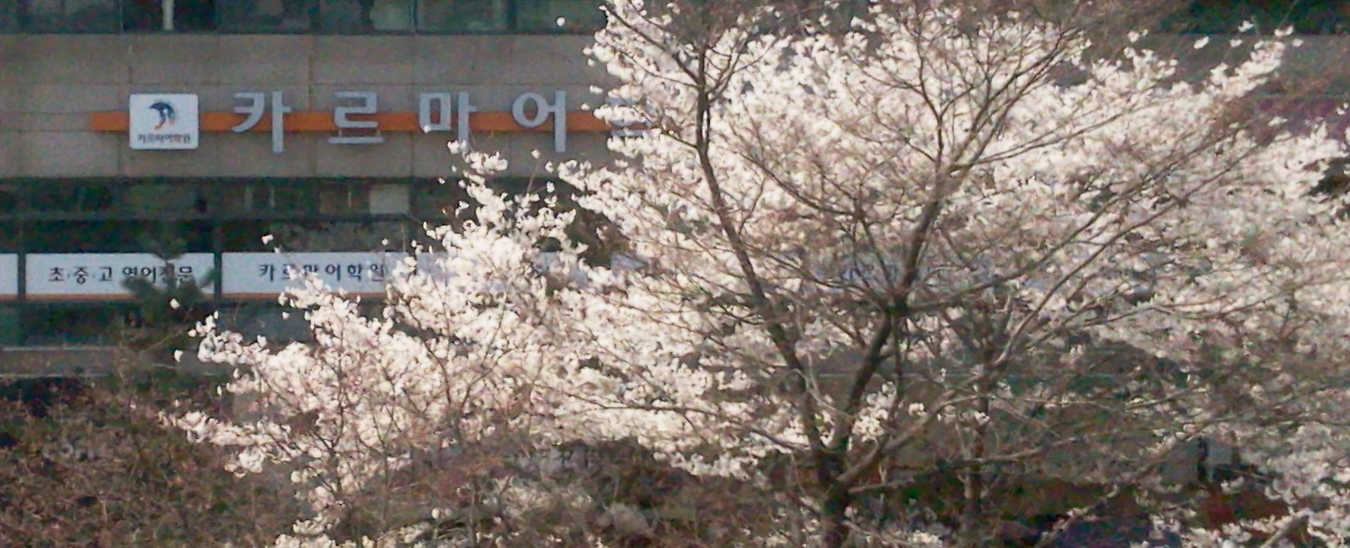
![]() [daily log: walking, 1km; chainsawing & woodsplitting, 1.5hr]
[daily log: walking, 1km; chainsawing & woodsplitting, 1.5hr]
Caveat: Tree #463
Sometimes I miss Korea a lot.
Here is a guest tree (or gathering of trees, with some attendant bicycles). I took this picture in December, 2017. I know exactly where it is – it’s behind the Gangseon Elementary School. I’m looking toward the southeast, so that’s the morning sun on the brick wall of the school. I was probably walking to work.

![]() [daily log: walking, 2km]
[daily log: walking, 2km]
Caveat: Tree #456
These trees (which one do you like?) are just outside the southwest entrance to the Jeongbalsan subway station in Ilsan (Goyang), South Korea. That was my “home” subway station for the majority of the time I lived in Korea, few blocks from the Urimbobo apartment building where both my first and last apartment in Korea was located (there were other apartments in between, however). I took this picture in November, 2007.
The banner on the footbridge, interestingly, is advertising a local performance of the Nutcracker Suite (호두까기 인형) at the Ilsan Cultural Center which is on the right behind the bridge.

![]() [daily log: walking, 2km]
[daily log: walking, 2km]
Caveat: peninsular psephological observations
I decided to take a break from documenting my visit to Oregon and my uncle’s health crisis to address the elections held this week in South Korea.
As my sister said, off-handedly, just now, “there are no coincidences in politics.” Thus, the fact that the Kim-DJT summit in Singapore was held this week, right before the elections, can hardly be imagined but to have been some bit of orchestration on the part of the South Koreans. And the incumbent president Moon Jae-in and his left-leaning 더불어민주당 [deobuleominjudang ~ “together democratic party”] clearly had decided that the blustery leaders’ drafty summiteering would benefit them electorally. It did.
Arguably, Korea experienced a “blue wave” such as some are forecasting for the US elections this Fall. Which is odd not just because Korea isn’t in the US, but because this is a kind of Korean mid-term, and as such, just like a US mid-term, you’d expect things to swing the other way. Since Moon had won in 2016, it seemed that things should swing rightward for this election. That didn’t happen. The main right-leaning party remains in disarray following the impeachment scandals that led to Moon’s election, and Moon is benefiting from domestic fears that Mr T is going to mess things up for South Korea.
So it goes. It’s interesting to compare the 2016 electoral map and the 2018 electoral map. You see the “blue wave”, barely noticeable and somewhat ambivalent in 2016, engulfing the country this time around. I have the 2016 map in my blog post from that election. And here is this year’s, below.
I like electoral maps. They’re interesting. Call me an amateur psephological cartographer.
![]() [daily log: walking, 5km]
[daily log: walking, 5km]
Caveat: What about alcohol?
Here is the Korean zeitgeist, as revealed in an offhanded comment by a sixth-grade girl who goes by Mindy:
Sometimes alcohol is necessary.
She said it in a chipper voice, as if conversationally stating the obvious. That would sum up the Korean perspective, easily enough.
[daily log: walking, 7km]
Caveat: la même chose
Every Spring is the same, in northwest Seoul. Smoggy. So… every Spring I become grumpy and “under the weather” – almost literally.
Actually this morning isn’t so bad. But the weekend seemed so, and last week was horrible. Such is life in the megalopolis.
Plus ça change, plus c’est la même chose.
![]() [daily log: walking, 7km]
[daily log: walking, 7km]
Caveat: 스키로봇챌린지
I like how these robots ski. It’s the best event from these Olympics at Pyeongchang, so far.
[daily log: walking, 2km]
Caveat: Random Poem #155
(Poem #456 on new numbering scheme)
신의 은총이 없었다면 저도 저렇게 되었을 것이다.
My coworker was sad. Her sister died. The cancer had declared its wish at last. The funeral was all the way across vast Seoul. These Koreans mourn the dead as they live - with kimchi and alcohol. The grace of god descended, so we kept our silences while poking rice with spoons and fetching bits of food with chopstick-thrusts. Of course my own unlikely failed demise was apropos - but felt indulgent too. I spoke about it with reluctance till at last we drove back down the Han to home. The night was cold. It carved heavenly paths; expressways sought to give us maps of hope.
Caveat: 3653 days
Ten years ago, today…
On September 1, 2007, I arrived in South Korea for my first teaching gig. I didn’t blog about my arrival until a few days later – I still hadn’t adopted the one-blog-post-per-day habit.
My first place of work was in a building less than two blocks from where I work now. One of my coworkers at that first job is still a current coworker, despite an intervening complexity of 6 different institutional employers. I had met two others of my current coworkers within the first 6 months.
Although Goyang is a city (suburb) of over 1 million residents, the Hugok neighborhood where I work is a village within the city, and over the decade it’s really changed very little, and many of the faces are the same.
The intervening 10 years have seen a few memorable adventures (including my year teaching down south in Jeollanam in a public school) and a long, drawn-out near-death experience: cancer, anyone?
I believe that the latter experience has fundamentally changed my personality. Perhaps not even for the worse – but I seem to have a much less adventurous spirit, now. I rarely fantasize about travel, anymore, whereas that was a near constant in earlier versions of myself. That, of course, is on my mind, since I’m going to be traveling, starting tomorrow, for only the second time since the cancer thing.
I still don’t have any clear feeling that this Korean life is permanent. There are strong reasons why it might not be – there’s some precariousness to it. Nevertheless, on a day-to-day basis, I operate on a fundamental assumption that this Korean life has, indeed, become my permanent lifestyle. It’s convenient to think that way, even if it’s not really true. It’s comfortable.
More later.
![]() [daily log: walking, 7km]
[daily log: walking, 7km]
Caveat: North Korea’s ICBM Program Makes Me Safer
I genuinely believe that North Korea's ICBM program makes me safer.
To understand what I mean, consider that I'm speaking, specifically, of me – I don't mean, here, some generic "me." I mean, I am a guy who lives about 20 km from North Korea. On a clear day, I can see North Korea from the top of a nearby hill – and that's not Sarahpalinesque hyperbole, either.
To be clear, North Korea's ICBM program probably makes the world in general a much more dangerous place. But my specific spot in the world becomes notably less dangerous.
Here's why.
You see, this spot, 20 km from the DMZ, and 25 km from the muzzles of North Korean artillery, has always been quite dangerous. For the last 70 years, it's been in the targeting sights of North Korean bomb delivery systems.
This has not changed. But with ICBMs, the North Korean has military has acquired a vast new selection of possible targets. 99% of these targets have greater strategic value, and fewer downsides, than bombing their own relatives in their own front yard.
What North Korean military planner wouldn't prefer to bomb Guam, or Washington, or even Okinawa or Nome, Alaska, over Ilsan or even Seoul?
So the chances of bombs suddenly raining down on Ilsan go down, each time they add kilometers to their overall ICBM range.
That's pretty basic.
In fact, I feel as if, to the extent that North Korea is able to attack the US directly, South Korea in general becomes safer. Why damage territory you hope to annex, when you can just directly attack that territory's current "protector"?
Now that doesn't mean I'm anything like complacent that I'm completely safe. To the extent that irrational minds (both in Pyeongyang and, increasingly, in Washington) walk down a path toward military confrontation, things get more dangerous, too. There might be an actual war, and if that happens, of course Ilsan is on the front line, so to speak. But the chances that Ilsan will be the "first victim" in some North Korean preemptive attack are fading quickly, and thus the area becomes a spot where "waiting out the war" becomes more plausible, to the extent you can accept that it seems unlikely that the North Koreans would be ultimately able to take any actual South Korean territory. I take that as a given in the current military climate. The North can only be preemptively retributive, if that makes any sense.
Maybe I'm just being unreasonably blind to military strategy and risks. But this is how I see it.
[daily log: walking, 6.5km]
Caveat: Baekje Rising
 Korea voted for president yesterday. I was quite confident already that the left-leaning candidate, Moon Jae-in (문재인), was sliding to victory. The right has been in disarray since the scandals broke around Park Geun-hye last year, and her impeachment and removal from office a few months ago, leading to this accelerated presidential election schedule, somewhat guaranteed that the electorate would swing leftward.
Korea voted for president yesterday. I was quite confident already that the left-leaning candidate, Moon Jae-in (문재인), was sliding to victory. The right has been in disarray since the scandals broke around Park Geun-hye last year, and her impeachment and removal from office a few months ago, leading to this accelerated presidential election schedule, somewhat guaranteed that the electorate would swing leftward.
The main right-leaning candidate for the new Liberty Party (the previous Saenuri Party, trying to rebrand itself in the wake of the scandals), Hong Jun-pyo, didn’t help matters by having Trumpesque crude sexist language come to light in his own past, including bragging about a date rape while in college. I had one coworker tell me that she would normally vote Saenuri (i.e. conservative, and probably, I speculate, because of her evangelical religious affiliation), but she couldn’t vote for Hong because he was “repugnant and disgusting.” I can only wish that US evangelicals could have been more morally upstanding vis-a-vis Trump.
So the conservatives shot themselves repeatedly in both feet, and the normally minority liberals wafted into the presidency, despite almost everyone disliking Moon almost as much as Americans seem to have disliked Hillary Clinton.
If one thinks in terms of policy and ideology, I also suspect Moon’s position was strengthed precisely because of Trump’s victory in the US. The Koreans deeply distrust Trump because of his being on the record to reevaluate the US “protection” of South Korea. Thus Moon’s stated intention to reexamine the relationship with the US probably resonated as well. How all this plays out vis-a-vis North Korea, I can’t really say. My instinct is that, to the extent the US and South Korea are NOT getting along, the North Koreans will be pleased and therefore LESS likely to do anything dangerous. So in fact my personal feeling, which is perhaps misplaced optimism, is that Moon’s election will be good for lowering tensions with the North.
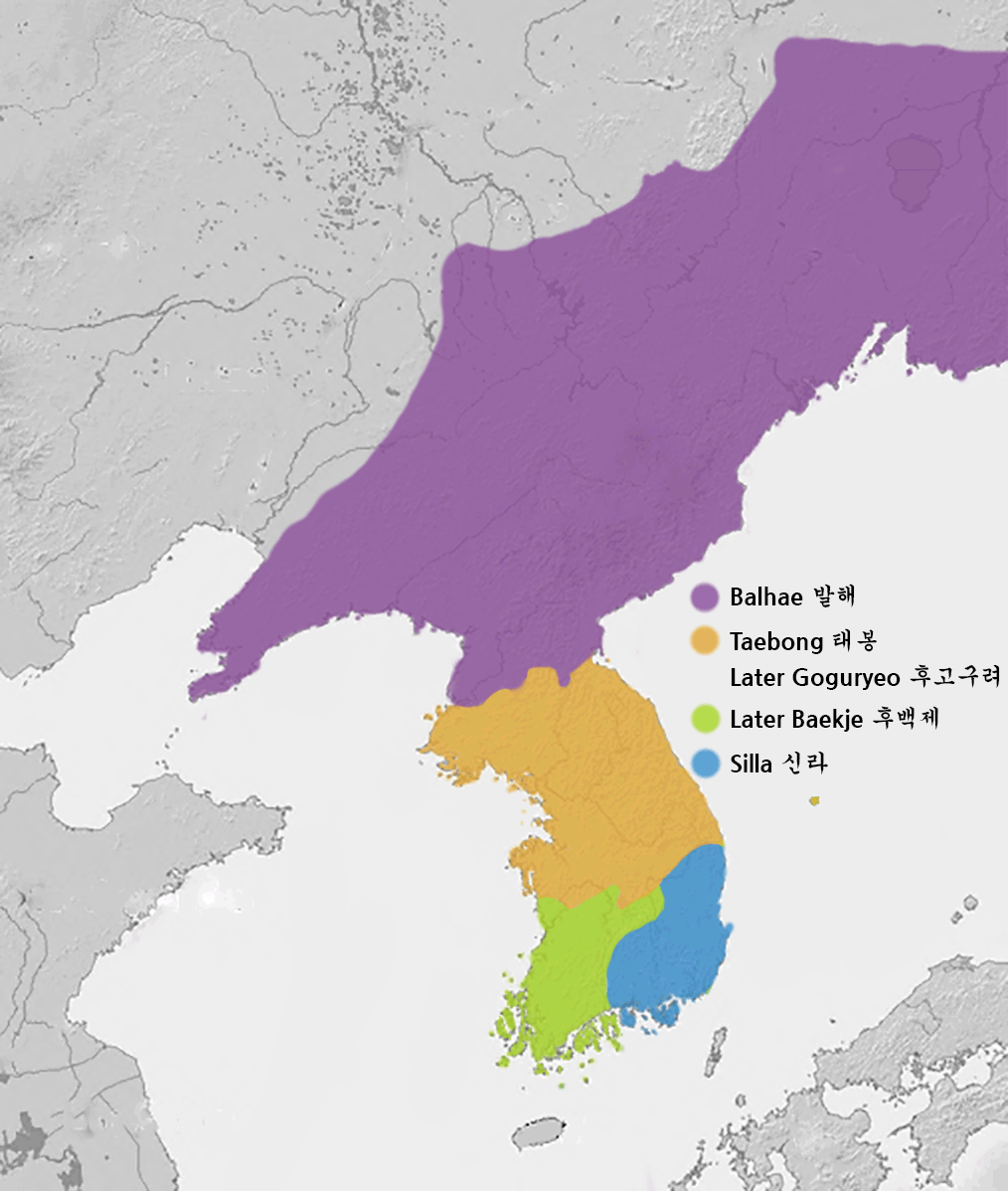 Having said all that, I want to return to something I looked at during the last election cycle: the ghosts in the electoral map.
Having said all that, I want to return to something I looked at during the last election cycle: the ghosts in the electoral map.
Moon’s victory map seems to parallel the 900AD “Late 3 Kingdoms Era” (후삼국시대 [husamguk sidae]) in Korea. Look at the two maps: the conservative “rump” in the southeast is later Silla, long past its glory days, while new Baekjae and the ascendant Goryeo dominate the peninsula – see the maps along the right.
I was thinking about this “ghosts in the map” idea because I also ran across someone who mentioned that Macron’s support in the recent French presidential election eerily paralleled the Plantagenet lands (i.e. English control) in 12th century France – see the maps below.

![]() [daily log: walking, 6.5 km]
[daily log: walking, 6.5 km]
Caveat: giving witch-doctors a bad name
As the evolving scandal around President Park Geun-hye and her "spiritual advisor" Choi Soon-sil continues to dominate the media, I have ambivalent feelings.
On the one hand, this reminds me a little bit of the potential scandal that never really took root around Nancy Reagan's reliance on astrologers. Imagine if it had turned out that there was documented evidence that Nancy's astrologers had been writing policy speeches for Ronald Reagan (and maybe this was true, but there was never any "smoking gun"), and that said astrologers had made billions of dollars through extortion and influence peddling to business leaders.
On the other hand, there is an element of "moral panic" about this scandal that is quite distasteful to me. My concern lies at the intersection between certain very conservative social forces in Korean society (linked to both Evangelical Christianity and traditional, Joseon-Era Neoconfucianism) and the long-standing cultural habit of condemning and persecuting the ancient shamanistic practices which are the substrate of Korean culture. These practices go under the rubric of "Muism" and have been persecuted and suppressed for at least 1500 years, since Buddhism became the state religion in the Three Kingdoms Era. Yet they remain quite strong, and they have always been connected to a kind of Korean "counterculture" that seems have an almost hippie-pagan flavor (in the sense familiar to westerners) yet is also deeply traditional. It helps to imagine Korean hillbillies.
I despise that this scandal is serving to reinforce the "superstition against superstition" that especially Evangelicals use to condemn nonbelievers. Yet the behavior of the President and her friend, in this context, has been self-evidently reprehensible. This is the sort of thing that could serve to increase the Christian right's stranglehold on South Korea's polity, if carefully spun.
As I've said before, there are positive ways that Christianity's weird, unprecedented takeover of South Korea during the last 50 years has enabled the culture to leapfrog out of its most xenophobic and caste-driven tendencies that were its premodern heritage, but I have always seen Muism and Buddhism, as well as Korea's many vibrant, unconventional syncretistic cults, such as they remain, as important counterweights to the excessive "holier-than-thou" moralizing and intolerance emanating from the mostly American-influenced, Pentecostal churches.
Actually, I find the odd links between one of those bizarre cults, 영세교 ([yeongsegyo], called "Church of Eternity" in English) and the Park dynasty (father dictator and daughter current president) fascinating. They might lend some insight into the Parks' odd relationship with the Korean establishment. That "church," founded by a former Buddhist monk, seems to be equal parts Christianity, Buddhism, and Muism. The daughter of the founder is the one at the center of the current scandal.
Caveat: Got my smart uniform / And my duty to perform
I was in the US Army, stationed at Camp Edwards, Paju (Geomchon), South Korea, in 1990. I hated my sergeant – he was corrupt, which distorted my chain of command.
He would volunteer our squad for details (extra tasks, like cleaning post latrines or moving boxes at the warehouse), currying favor with the Company CO, and then promptly disappear, to meet with his girlfriend at the post NCO club (bear in mind that he was married, with a wife and kids back in the States, and that his girlfriend, as an enlisted member of the same battalion, was off-limits due to rules about fraternization). The rest of the squad was on the line for getting the detail done.
The sergeant was a terrible hypocrite, and it was only a matter of time before I got out of line and said something insubordinate. When I did, I was disciplined. The company CO put me on an "extra duty" detail that was, in fact, the best thing that happened to me in the Army.
I was obligated to ride as a "US military presence" with a group of Korean civilians whose job it was to go onto US bases all over Gyeonggi Province and collect boxes for shipment of personal effects of US service personnel, via civilian courier, back to the US (or to other US military bases around the world). I think basically I was with them to provide a kind of "peace of mind" to the US military personnel who were entrusting their possessions to the Korean civilians. I accompanied an ROK NCO who was functioning as a "Customs liaison" – his job was to make sure no US soldiers were shipping contraband. My job was just to tag along so that the military presence was "bi-national," as far as I could tell. I had no actual duty whatsoever, although at the start of the duty I'd been forced to memorize a set of Korean customs regulations as applied to US service personnel.
I was never called upon to make use of this information, however. Sometimes the ROK soldier would make me hold his clipboard. Typically, the Korean soldiers always enjoyed chances to be "in command" of US soldiers, and I was happy to go along with it, for the most part. None of the Korean NCO's I worked with were in any way corrupt compared to the US NCO's at Camp Edwards, who, with the shining exception of Staff Sergeant Jones (a few links up my chain of command, and the closest kind of "friend" I had during this period), were all a pretty bad bunch.
 The ROK soldier, who was a different person on different days, was really the only person who had any English competency at all. The Korean "ajeossis" who packed the boxes and drove the truck had only a few limited phrases. They were exceedingly kind and friendly toward me, however, and during my 3 months of special duty, I became a part of their "team," in a way that never occurred with the ROK soldiers. I was their pet American. I spent between 6 and 8 hours a day with this team, 4 days a week. I loved riding around the Korean countryside with them, from US base to US base, from Panmunjom (several times) all the way down to Osan. I got to visit every single active US military installation in the region, while spending most of my time in transit between, stopping at bunshik joints at the side of the highway and eating excessively spicy ramen with slices American cheese floating on top – a favorite of these men. I learned some of my first phrases of Korean. All these years later, they are still the few phrases that come most naturally to me.
The ROK soldier, who was a different person on different days, was really the only person who had any English competency at all. The Korean "ajeossis" who packed the boxes and drove the truck had only a few limited phrases. They were exceedingly kind and friendly toward me, however, and during my 3 months of special duty, I became a part of their "team," in a way that never occurred with the ROK soldiers. I was their pet American. I spent between 6 and 8 hours a day with this team, 4 days a week. I loved riding around the Korean countryside with them, from US base to US base, from Panmunjom (several times) all the way down to Osan. I got to visit every single active US military installation in the region, while spending most of my time in transit between, stopping at bunshik joints at the side of the highway and eating excessively spicy ramen with slices American cheese floating on top – a favorite of these men. I learned some of my first phrases of Korean. All these years later, they are still the few phrases that come most naturally to me.
There were long waits, sometimes. I carried my current Dostoyevsky or Gogol novel and would read. The Camp Edwards post library inexplicably had an excellent collection of Russian literature in translation, and thus my year in Korea was when I worked my way through most of the Russian greats. I also had my little Sony Walkman (this was 1990, right?). I only had 4 cassettes, however. So they were on constant rotation.
One of those tapes was Nik Kershaw. Even now, if I hear one of his songs, I become exceedingly nostalgic for those road trips along the DMZ with those ajeossis. This is even stronger when the day is drizzly and gray, late Summer fading into early Fall, and I look out my window at the same Korea I saw then (with a few buildings added). The picture (found online), above right, shows the south check point, back in the day, which I remember vaguely. It's less than 10 km from my current home. I start craving spicy cheese ramen.
What I'm listening to right now.
Nik Kershaw, "Know How."
Lyrics.
Got a badge upon my chest
I'm a cut above the rest
So I can tell you what to do
Got my regimental hat
Got my "by the good book" chat
So I can tell you where to go
I've got a job to do and I'm telling you
I intend to do it well
It's easy when you know how
Got my smart uniform
And my duty to perform
So I
Don't care you who you are
I'm the only one who can spoil your fun
With one shake of the head
It's easy when you know how, know way
Know where and know today
Know mercy, know time
Know reason, know rhyme
Know how
I can tell you I'm the law
With my medals from the war
So don't tell me what to do
With my narrow point of view
Though I know you're probably right, I guess
It's still not easy saying yes
It's easy when you know how, know way
Know where and know today
Know mercy, know time
Know reason, know rhyme
Know how
[daily log: walking, 1.5km]
Caveat: The Kimchi Croquette
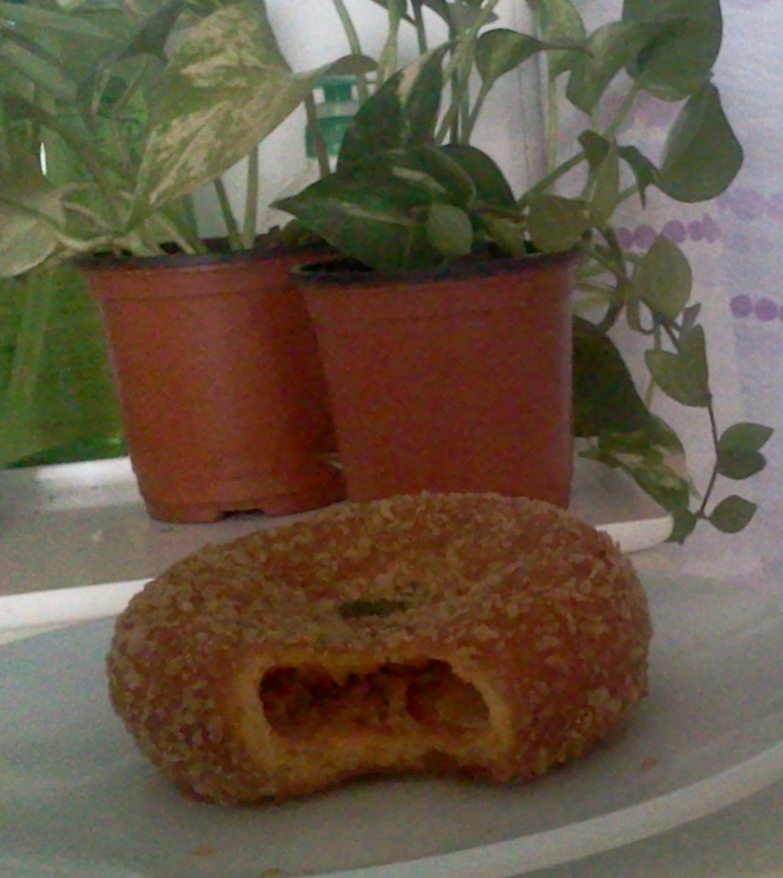 In the weird fusion culture that is South Korea, 2016, I can walk down to the corner Tous les Jours franchise (a pseudo-French bakery chain) and buy a "kimchi croquette."
In the weird fusion culture that is South Korea, 2016, I can walk down to the corner Tous les Jours franchise (a pseudo-French bakery chain) and buy a "kimchi croquette."
I couldn't resist trying one. Actually, it wasn't that unpleasant – sufficiently moist and squishy, when heated up, that it was not difficult to eat for my jangae mouth. And the kimchi added a nice bite to what would otherwise just be a greasy blandness.
Today begins the most important holiday of the year, the Korean thanksgiving ("추석"). It's always "8-15" on the old, lunar calendar, but it floats around the September/October timeframe on the Gregorian – every year is different.
I have vast, megalomaniacal plans to do as little as possible with great mindfulness and intentionality.
[daily log: walking, 2km]
Caveat: 2016총선
Korea voted for parliamentary representatives yesterday (this is called 총선, “general election”). The atmosphere as I walked to work was quite strange – a “real” holiday. The schools were closed and workers are given time off (half days or complete off days depending on their work type and schedule, but the hagwon business, such as where I work, is exempt from this and so we worked as normal). There were lots of senior citizens going in and out of polling places, and parents were out in playgrounds playing with their kids. It was nice, and the feeling was vaguely festive.
My friend Peter has been blogging in a very detailed and interesting manner about election-related issues. I have enjoyed reading his thoughts. I haven’t, myself, been following these elections as closely as in the past – I have been feeling a kind of bitter resignation about the phenomenal lock on power held by the conservatives in Korea, and this election appeared to be only a further entrenchment of this “neo-Parkism,” embodied by the presidency of the dictator’s daughter, with a fragmented opposition that seemed destined to do badly.
In fact, the opposition didn’t do so badly, on preliminary results – I have been looking at Naver News’ summary coverage (in Korean). The president’s 새누리당 (Saenuri Party) lost its parliamentary majority, Ahn Cheol-soo’s new third party, 국민의당 (People’s Party) did remarkably well, and even the 더문주당 (Minjoo Party) surprised at least me by turning Gyeonggi blue on the electoral map, despite losing their main stronghold in the southwest to the upstarts. Turnout was higher than in the last several elections.
I walked past 4 different polling places on the way to work (all schools). Below is the Ilsan Service Industry Workers Vocational High School (called, optimistically, the “International Convention High School”, but really a dumping ground for Ilsan’s least ambitious students), with a polling place banner across the entrance gate.
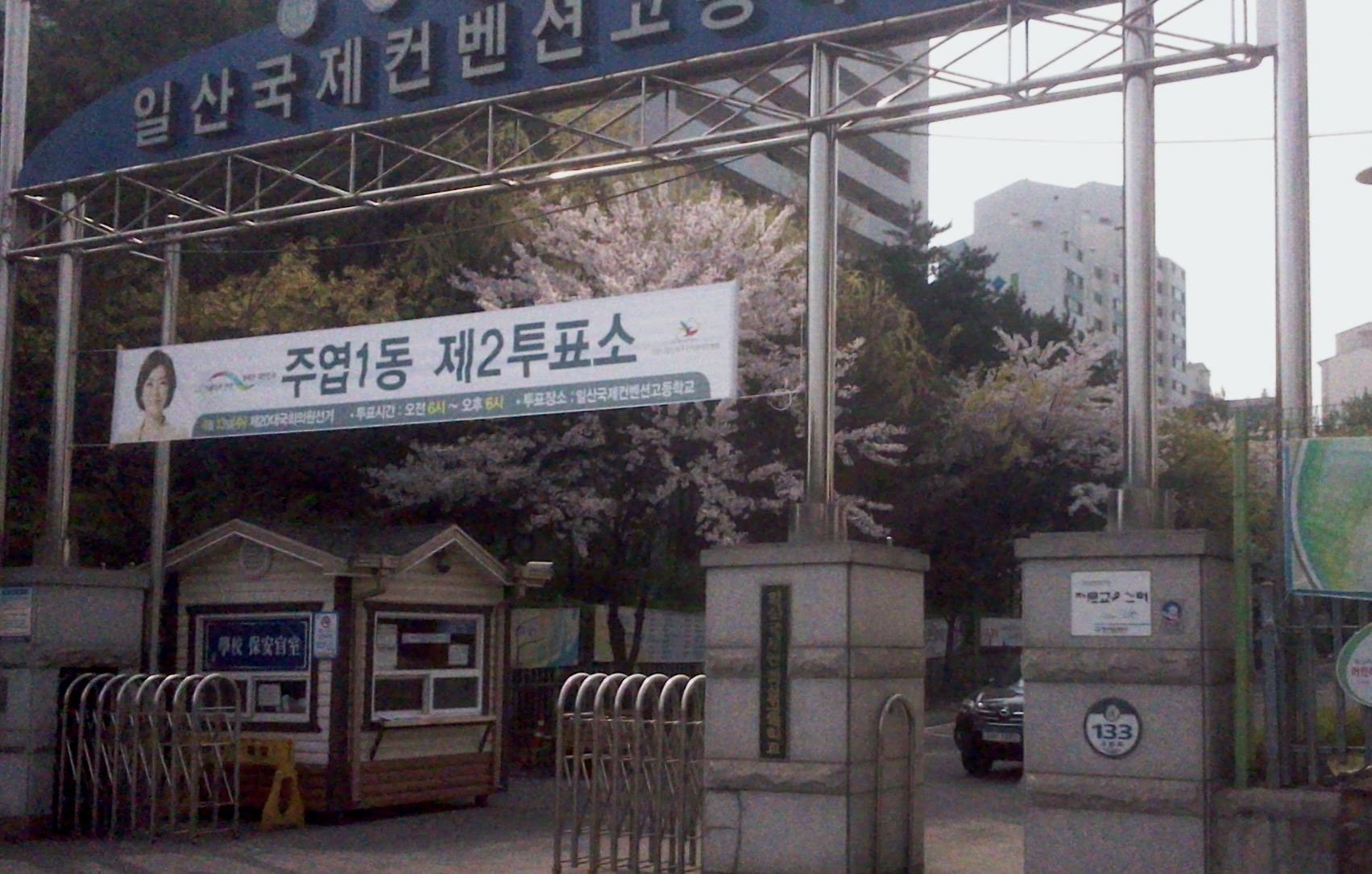
[daily log: walking, 7km]


